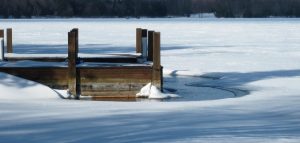2023-Oct-20
Important Safety Considerations for Bubblers

Winter is coming and we all want to protect our properties as best we can. If you use or are considering installing a bubbler to prevent ice damage, there are some import issues to consider.
Bubblers are a type of de-icing system that prevent ice from forming around waterfront structures by creating zones of agitated and warmer water. Without careful planning, management, and consideration of the nature of your waterfront area, your bubbler can de-ice a significantly larger portion of the water than is necessary to protect your property creating large areas of open water.
Legal Implications
There is no law against using a bubbler, but Section 263 (1) of the Criminal Code of Canada (Duty to safeguard opening in ice) is very clear that those who make or cause to be made an opening in ice are under a legal duty to guard the opening in a manner adequate to prevent persons from falling in by accident, and adequate to warn them that the opening exists. If you fail to perform these duties, the Code states that you may be found guilty of serious offences, up to and including manslaughter. These are serious consequences that could be more costly that spring dock repairs.
 Risk Management Considerations
Risk Management Considerations
If you chose to operate a bubbler to protect your property, please make sure you are taking all steps possible to mitigate your risk and ensure the safety of all lake users. Cade Insurance makes the following recommendations:
- Place and angle your devices with care to keep the impacted area as localized as possible;
- Talk to your neighbours to avoid doubling up in an area. It is possible that one bubbler will do the trick.
- Equip your system with a thermostat or timer control. Running 24/7 may create oversized openings.
- Place clear signs near the bubbling area, visible from all directions noting “Danger Open Water”.
- Run an amber light to mark the hazard at night and during storms. Do not use a red light, as this can be mistaken for the brake lights of a snowmobile and draw people towards the risk, rather than turn them away.
- Monitor your property. If you cannot be present, have someone check regularly to ensure the system is operating, the effected area is appropriate in size, and that the warning lights and markers remain in place.
- Where possible, a knowledgeable and experienced contractor should be used to configure the system.
The onus is on the property owner to understand the risks, exercise good judgement and be mindful of everyone who uses the ice in the winter.
For additional Information on bubblers and the safety considerations, see:
